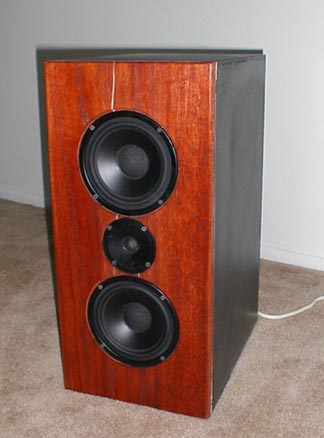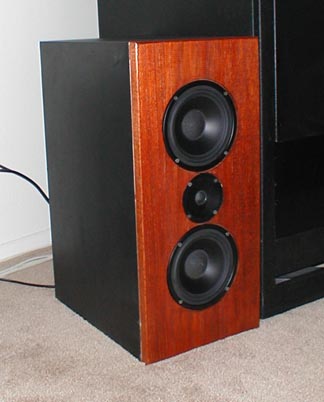|
Using
Solid Wood in Speakers FAQ (Work in Progress)
by Louis Lung
original
revision 0.1; 09 January 2001
revision 0.2; 21 March 2001
Disclaimer
The information
presented here is provided as-is and is believed to be correct
at the time of its writing. No guarantees, implicit or otherwise
are provided. Use this information at your discretion. Neither
the author, nor contributors, are responsible for any injury,
damage or loss, directly or indirectly related to the contents
of this FAQ.
Woodworking
is potentially dangerous. Make sure you understand the proper
use and operation of any tool before using it. Remember -
Safety First !
Notice
The goal
of this FAQ is to provide information pertaining to the use
of solid wood (sometimes refered to as lumber)
in speaker building. While much of the information contained
here pertains to woodworking in general, the emphasis is on
speaker building.
In creating
this FAQ, I consolidated various pieces of email I had previously
written for the Bass List with some new material, and am presenting
it in a Q&A format.
Purpose
Speakers
can be made from all kinds of materials. For commercial off-the-shelf
speakers, particle board is typically used. Higher quality
speakers often use medium density
fiberboard (MDF). Yet others use materials ranging from
concrete to stone to composites. Just about anything is possible.
For the hobbyist, the obvious choices are typically readily
available building materials from the local lumber yard or
warehouse store.
Among DIY
cicles, natural wood (a.k.a. lumber or solid wood) is a common
choice. Solid wood offers the appeal of wood's natural beauty
and gives the feel of a heavy, dense, handcrafted speakers.
But like all things made of natural wood, the results are
not always easy to predict.. Each building material has its
own set of characteristics and wood is no exception. The purpose
of this FAQ is to provide relevant information on the use
of wood in speaker building. The goal is not to tell somene
what to do and what not to do - that is purely the builder's
decision. Rather the goal is to provide a foundation on which
the builder can make an educated decision after assessing
both the risks and thebenefits of using lumber.
Table of
Contents
Q:
What is meant by Solid Wood or Lumber ?
A:
In this FAQ, the terms "wood", "solid wood"
and "lumber" are used interchangeably. Solid wood
is real, natural wood; not a man-made material. Examples of
a man-made wood product are plywood, particle board, medium
density fiberboard (MDF), and flakeboard.
Q:
In general, is it a good idea to use Lumber for speakers ?
A:
In general, it is not a good idea to make an
entire speaker out of solid wood. This is not to say that
it can't be done; just that the average builder should not
consider doing so without a good solid understanding of the
issues. There are some places in a speaker where it is generally,
relatively easy to use solid wood. In other places, solid
wood is more difficult to use properly.
The two
main reasons for not using wood are (1) wood's non-uniform
characteristics and (2) wood's movement. The former affects
the sonic qualities of the speaker box, the latter affects
the integrity of the box with changes in the environment.
Q:
Wood is nice and dense; it must be better than man-made materials
right ?
A: Some
hardwoods are denser than man-made composites, offering what
appears on paper to a superior material for speakers. However,
this density varies millimeter to millimeter within the wood
- growth rings are the simpliest was to "see" this
change in density. Density also varies at a larger scale,
from board to board, tree specimen to specimen.
Because
wood is a natural material, it lacks uniformity thus making
it a poor choice as the main building material for speakers.Ultimately,
it is not density alone that makes one material better than
another. Uniformity is much more important and solid wood
cannot match the uniformity of man-made composites like MDF.
Remember
that while the quality of a musical instrument (such as a
violin) is often associated with the particular sound it produces,
a speaker box is not supposed to produce any sound at all;
only the drivers are supposed to cause sound. The box resonances
that cause the box to "sing" in a totally wooden
box are much harder to tame than in a composite box.
Q:
What is wood movement ?
A: Wood
movement is the expansion and contraction of wood as it absorbs
and releases moisture.
Q:
What affects wood movement ?
A: Many
factors affect wood movement. Below are some of the obvious
ones though there are probably more.
- The cut
of the wood -
- The humidity
-
- The temperature
- The finish
applied -
Q:
OK, so wood moves. Why does that matter ?
A: The
total amount of movement is proportional to the size of the
piece so for small pieces of wood, these changes are extremely
small and will not likely cause problem. One typical use for
small pieces of solid wood is along the edges of speaker panels
where a roundover (radius edge) is more easily obtained with
solid wood and much more difficult to do with veneers.
Because
speaker baffles and side panels are much larger than edge
trims, movement in lumber can be significant and may cause
problems. Here are pictures of two speakers made of MDF with
a solid wood baffle. The wood is stained hickory with a clearcoat
(by Ray Wagner, used with permission).

This one
has a cracked baffle.

while this
one remained intact.
The moral
of the story is that using lumber in a speaker may
cause problems, but like all natural things, you'll
never for sure until it happens. How lucky do you feel ?
Q:
Do some woods move less than others ?
A: Yes,
each species has its own characteristics.
Q:
Do some cuts of wood move less than others ?
A: Yes.
Radial wood movement (quatersawn lumber) is typically less
than tangential movement (plain sawn). How much less ? If
you look up the charts, most woods have radial movement in
the range of 30% to 70% of tangential.
Q:
Can I prevent wood from moving ?
A: Practically
speaking, you can't. Better yet, you shouldn't try to. [fill
in]
Q:
If I put a finish on the speaker, wouldn't that seal the wood
and keep it from moving ?
A:
A surface finish reduces the rate of moisture
transfer but does not eliminate it. Different finishes affect
the rate differently so reaching EMC (equilibrium moisture
content) will take different amount of time with differing
finishes.
Q:
What's the problem with a cross-grain wood joint ?
A: [fill
in]
Q:
Since glue is said to be stronger than wood, why can't I just
glue it down and prevent it from moving ?
A: [fill
in]
Q:
If wood moves, wouldn't normal wood furniture have the same
problems ?
A: Yes.
In fact anyone collecting antiques will tell you that panels
made from solid lumber usually fail the test of time if they
are not allowed to move. Wood movement doesn't have to be
bad. It's only a problem when the construction does not allow
it to move. That's why glued (or otherwise movement limiting)
cross-grain construction is bad and why floating panels are
used in quality solid wood furniture.
Q:
If cabinet makers can solve wood movement problems, why can't
I use the same techniques on speakers ?
A:
Floating panel construction is typically used to account for
wood movement in furniture. In a speaker a floating panel
is risky to implement - since it's designed to move, it can
rattle. The rattle can be limited by various means but suffice
it to say that it's not your typical construction. It also
won't be airtight so it'll need an additional airtight interior
box.
Q:
I've seen/made/heard of wooden speakers that don't have any
of the problems you describe. What's the deal ?
A: [fill
in]
Q:
I really want to use lumber. Is there any way to still use
it in my design ?
A: [fill
in]
Q:
Isn't plywood made from wood ? How come it doesn't have movement
problems ?
A: [fill
in]
Q:
What if I glue wood to a box ?
A: [fill
in]
Q:
Isn't veneer wood ? Why doesn't it have movement problems
?
A: [fill
in]
Q:
I really like the look of real wood. How can I get that look
without using lumber ?
A: The
simplest method is to use a veneer. Wood veneers are thin
slices of wood which are glued to a stable substrate - your
speaker box. Veneers offer several advantages :
- Once
glued to a stable substrate, they will not have lumber's
movement problems.
- They
are much more environmentally friendly than solid wood.
They are sliced, not sawn so there is much less waste. Each
tree yield many more square feet of coverage as a veneer
than as solid wood.
- There
are several ways to slice a veneer from a log. Some methods
yield a veneer with an appearance not obtainable from lumber.
- Some
rare and/or expensive wood species are only available as
veneers.
- Veneers
can be glued on curved surfaces.
- Veneers
easily cover up ugly boxes made from composites giving both
the advantages of man-made materials and the beauty of wood.
- Pre-veneered
furniture-grade plywood requires no veneering skills, and
comes in many different species of wood.
See Keith
Lahteine's Veneering Wood and
Plastic Laminate primer for more information on veneering
A:
For those not satisfied with the look or "feel"
of a veneer, it is possible to make your own plywood from
lumber.
Q:
Where can I get more information on wood ?
A: Check
out the following :
I left out
a lot of details that are beyond the scope of this FAQ. Anyone
wanting more information on wood and its properties should
check their local library and/or online sources.
Q:
Where do I send comments, suggestions, additions and corrections
for this FAQ ?
A:
See the "About" page on this site.
|